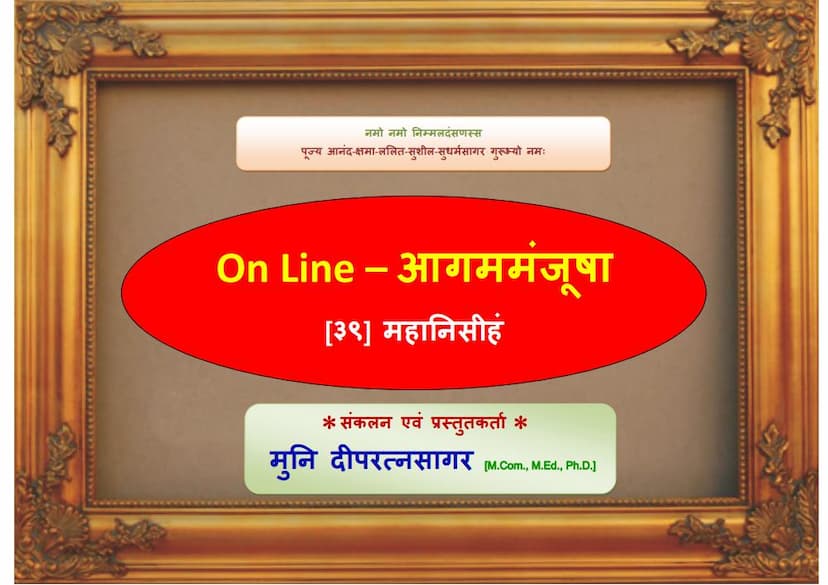Aagam Manjusha 39 Chheyasuttam Mool 06 Mahaanisiham
Added to library: September 1, 2025

Summary
The provided text is the Mahanisiham sutra from the Agam Manjusha series, specifically the sixth part of the Chheyasuttam. The text is presented in an online format, with its origins traced back to a 70-year-old edition from 1942 compiled by Acharya Shri Anand Sagar Suri, and later digitized with some modifications by Muni Deepratnasagar in 2012.
The core of the text, as indicated by the initial verses and the extensive Prakrit dialogue, delves into Jain ascetic practices, ethical conduct, the consequences of actions (karma), and the path to liberation (moksha).
Here's a breakdown of the key themes and content based on the provided pages:
1. Introduction and Context:
- The text is a Jain Agam, specifically the Mahanisiham sutra.
- It is presented as part of the "Agam Manjusha" series, with a spiritual lineage acknowledged from Pujya Anandsagar Sagar Guru.
- The digitization effort by Muni Deepratnasagar highlights the preservation and accessibility of these ancient Jain scriptures.
2. Core Teachings and Principles:
- The Path of Renunciation and Restraint: The initial verses emphasize the importance of living a life of restraint, free from passions, attachment, and aversion. The goal is to achieve a state of equanimity and detachment.
- Karma and its Consequences: A significant portion of the text explores the intricate workings of karma, detailing how actions, whether mental, verbal, or physical, lead to consequences in this life and future lives. The text vividly describes the suffering caused by negative karma and the suffering in various states of existence (hell, animal, human, celestial).
- The Nature of Suffering: The Mahanisiham illustrates the profound suffering inherent in the cycle of birth and death (samsara). It describes various forms of physical and mental suffering, emphasizing the impermanence of worldly pleasures and the inevitability of pain and loss.
- The Importance of Right Knowledge, Faith, and Conduct: The text repeatedly stresses the foundational principles of Jainism: samyak darshan (right faith), samyak gnana (right knowledge), and samyak charitra (right conduct). These are presented as the path to purification and liberation.
- Prakrit Dialogue and Ethical Dilemmas: The bulk of the text consists of dialogues, primarily between Lord Mahavir (implied as the speaker) and his disciple Gautam Swami. These dialogues address a wide range of ethical scenarios, including:
- The dangers of attachment and desire.
- The pitfalls of the senses and passions (kashayas: anger, pride, deceit, greed).
- The importance of introspection and self-awareness.
- The consequences of seemingly minor transgressions.
- The strict adherence to vows and principles by ascetics (sadhus and sadhvis).
- The detailed descriptions of various sins and their resultant karmic consequences, particularly focusing on the suffering in different hellish realms.
- The Role of Penance and Auspiciousness (Mangal): The text emphasizes the significance of penance (tapasya) and auspicious rituals or practices (mangala) as means to overcome negative karma and progress on the spiritual path. The "Panch Mangal" (Five Auspicious Ones) are invoked, indicating their importance.
- Distinguishing Righteousness from Deception: A crucial theme is the exposition of true spiritual practice versus outward show or hypocrisy (maya and dambha). The text differentiates between genuine ascetics and those who merely wear the guise of spirituality, highlighting the detrimental consequences of the latter.
- The Concept of "Kushil" (Bad Conduct/Unrighteousness): A significant portion is dedicated to defining and illustrating various forms of unrighteous conduct, particularly those that lead to spiritual downfall. This includes offenses related to knowledge, perception, conduct, penance, and association with unrighteous individuals.
- The Significance of the Guru and Discipleship: The dialogues often revolve around the guidance of the spiritual preceptor and the proper conduct of the disciple. The text emphasizes the importance of respecting and following the teachings of the guru.
- The "Mahanisiham" Sutra's Specific Focus: While the general themes are common to Jain Agams, the "Mahanisiham" appears to focus on specific, often severe, transgressions and their meticulous expiation through penance and atonement. The detailed descriptions of suffering and the classifications of sins suggest a profound exploration of the nuances of karmic bondage and liberation.
3. Specific Examples and Narratives:
- The text includes a lengthy narrative about a king named Suman and his daughter Lakshmidevi, illustrating the dire consequences of attachments, wrong beliefs, and the breakdown of ethical conduct, leading to transmigration through various difficult life forms and ultimately to suffering. This narrative serves as a cautionary tale.
- The dialogues also touch upon the spiritual journey of individuals, the conditions for attaining omniscience (keval gnana), and the ultimate state of liberation.
In essence, the Mahanisiham sutra, as presented, is a profound and extensive discourse on the spiritual path within Jainism. It serves as a comprehensive guide to understanding the intricate laws of karma, the pervasive nature of suffering in the world, the essential ethical principles, and the arduous yet ultimately rewarding path of asceticism and devotion leading to liberation. The emphasis on meticulous observance, the dire consequences of even minor transgressions, and the importance of correct knowledge and conduct underscore its significance within the Jain tradition.